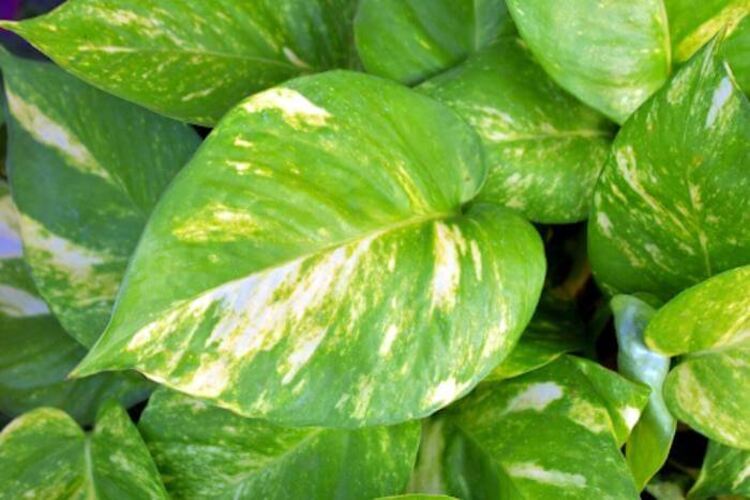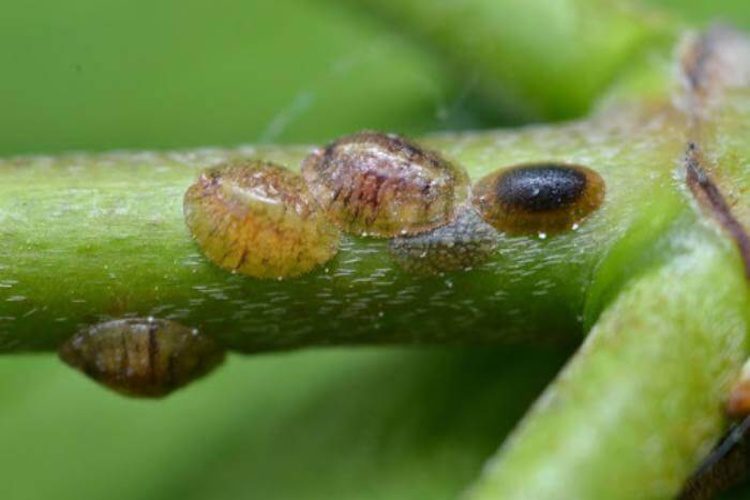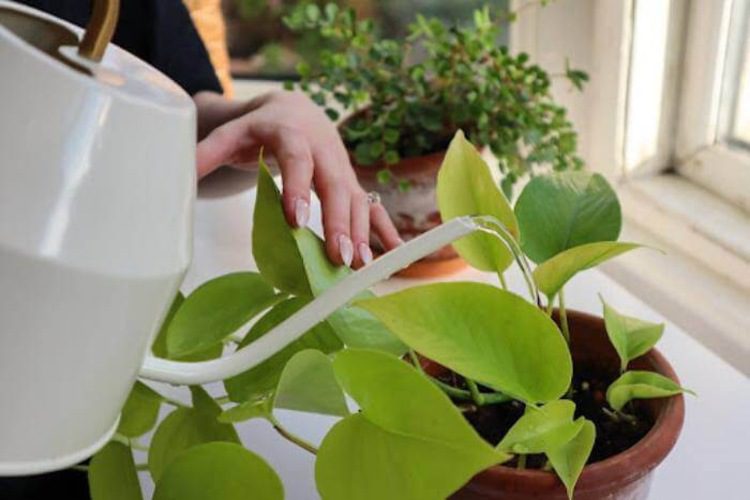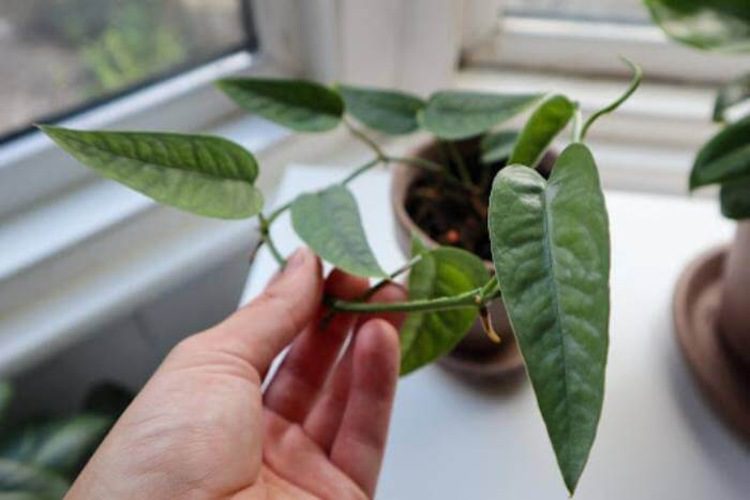How To Get Rid Of Bugs On Pothos? 3 Methods To Treat
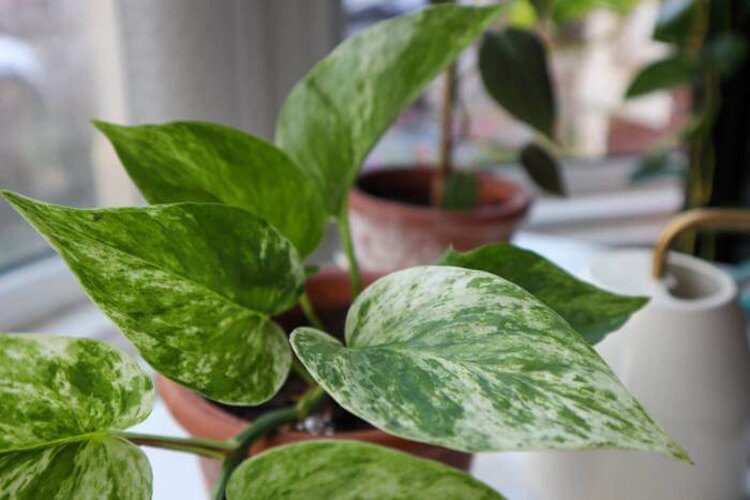
Pothos plants attract bugs, but those bugs are a nightmare for the plants. If you notice some of them on your pothos, take immediate action.
How to get rid of bugs on pothos? Fortunately, those annoying creatures are not the end of the world. This guide has all the tips you need to recover your plant. Let’s figure it out!
How To Get Rid Of Bugs On Pothos?
There are three main ways to remove bugs from your pothos. Let’s read through them and determine which works best for you.
Physical discard
If you can detect the bugs, discarding them physically will be the simplest solution to try. Be gentle, as your pothos plant may get hurt. Thorough cleaning with a powerful stream of water will also kill pests. However, it’s only suitable for some kinds of bugs and may affect the healthy parts of your plant. Hence, we still prefer removing them by hand.
Natural remedies
You can choose one from various horticultural oil options to get the bugs killed. We highly recommend this method, as it’s gentle and effective.
Neem oil
Neem oil is one of the most common horticultural oil solutions. You can use it to deal with almost any kind of bug. Neem oil will alter the hormones and brains of the bugs. After the treatment, they will stop feeding and reproducing on your plant. Finally, they will die.
After spraying the neem oil solution on your indoor plant, it will look limp for a while. But don’t worry, as it will recover soon. The recovery time after a neem oil treatment is about 10 to 15 days, depending on how severe the pest infestation is.
Sticky traps
Yellow sticky traps in indoor plants can work on many pests, such as mealy bugs, scale insects, thrips, and whiteflies. You can create sticky traps by using petroleum jelly or engine oil to smear sticky paper.
Soap spray
Insecticidal soap can eliminate many houseplant pests, such as mealybugs, scale insects, or aphids. But you should start by washing the bugs with water. Next, prepare the insecticidal soap by mixing mild dish soap, oil, and warm water in a spray bottle. Then, give your plant a thorough spray.
Botanical oil
Aside from neem oil, botanical oil can also be a good solution. It contains mineral oils, soybeans, and cotton seeds, which are ecologically friendly ingredients. You can use botanical oil in the same way as neem oil. Treat your plant with the solution once a month to prevent bugs.
Garlic spray
Garlic has been famous for treating insects. To make the spray, you need to soak the garlic in mineral oil overnight to form a garlicky oil. On the next day, mix garlic oil, dish soap, and water in a spray bottle. Then, spray it on your plant.
Chemical remedies
Chemical solutions have a fast effect. However, because of the chemical ingredients, they can be harmful to humans and animals.
Pyrethrin
Pyrethrin works as a mild botanical cure for houseplant pests. It arrives as a powder or a spray that quickly brings down and suffocates flying insects. To completely get rid of them, you can mix pyrethrin with another insecticide. Even after removing all the pests, spray the solution on your indoor plant to prevent them from returning.
Pesticides and fungicides
If all the methods above don’t work, pesticides and fungicides will be the last line of defence. They intend to kill and control bugs quickly. However, please note that the chemicals in those solutions can be toxic to animals and us. So remember to follow the instructions strictly to stay safe.

What Do Bugs On Pothos Look Like?
Bugs, like scale insects, don’t have natural predators in your house. Hence, they can thrive and cause Pothos problems. Your first task is to identify the bugs on your Pothos. There are multiple types of bugs, each with a unique appearance and leading to different consequences.
Most bugs in indoor plants are too tiny to see with our naked eyes. For example, spider mites are only 1/12 inch long, and fungus gnats can’t grow bigger than 1/8 inch. Moreover, some bugs, like scale insects, don’t really have an insect-like appearance. So, the best solution to finding pothos bugs is to check for the signs. Then, pay closer attention to certain parts of the plant to confirm.
This summary table will help you picture how they look.
| ugs | Appearance | Symptoms |
| Spider mites | Aphids have a pear shape and soft bodies. They can be wingless or winged. Besides, they come in different colours, including yellow, red, white, and black. | – Yellow or brown spots – Yellow leaves – White webs – Drooping leaves – Stunted growth |
| Mealybugs | Mealybugs are pink and look like grey or white cottony masses. You can find them on the underside of the stems, whorls, or leaves. | – Distorted growth – Cotton-like mass under the affected parts – Sticky traps – Leaf drop – Chlorosis or paling – Holes on leaves |
| Whitefly | Whiteflies are soft insects, but they don’t fly. They have a triangular shape and will form colonies with their eggs underneath the pothos leaves. | – Distorted growth – Sooty mold – Pale, yellow, brown, and wilting leaves – Tan or white eggs underneath the leaves |
| Scale | – Poor development – Black or grey insects flying around the plant – Sudden leaf wilting and yellowing | – Leaf yellowing – Stem and leaf dieback; Stunted leaves – Sooty mold – Leaf chlorosis or paling – Drooping and sickly leaves |
| Thrips | Thrips are fringe-winged insects. You won’t see them easily due to their tiny size. They will lay eggs in the Pothos leaves. | – Silver or white steaks on the leaves – Distorted leaves – Brown holes in the foliage |
| Aphids | Aphids have a pear shape and soft bodies. They can be wingless or winged. Besides, they come in different colors, including yellow, red, white, and black. | – A white colony underneath the leaves – Stunted leaves – Fungus gnats and sooty mold – Yellow leaves |
| Fungus gnats | Fungus gnats are tiny and look like mosquitoes. They often thrive in moist soil, eating the plant roots. | – Poor development – Black or gray insects flying around the plant – Sudden leaf wilting and yellowing |
Why Are Bugs Getting To Your Pothos And How To Avoid Them?
Why do pothos plants attract bugs? Knowing the cause will help you avoid it effectively.
High humidity
Houseplant pests find a humid environment attractive. These bugs have soft and tiny bodies. To avoid becoming too dry and ending up dying, they need moisture to survive. If you overwater your pothos plant, there will be standing water on the plant and the soil. As a result, the humidity level increases. Things get worse if there isn’t enough ventilation in the area.
Poor ventilation
Your Pothos’s development and general health rely on effective air circulation. Adequate aeration keeps humidity low and inhibits the growth of houseplant pests. Moreover, bear in mind that aeration accelerates the drying of damp leaves and potting soil. Hence, bacteria can’t grow.
There is typically less ventilation when you keep your pothos plants too close together. Pests will form and transfer easily from one plant to another.
Overfertilization
Some gardeners assume that more fertilizers will help their indoor plants grow faster. However, it isn’t accurate as plants have different requirements.
Overfertilization, such as too much nitrogen, will cause your pothos leaves to get thinner. Then, they will become more vulnerable to bugs. It would be best to only fertilize pothos plants every two or three months and do it during their growing period. They love well-balanced and water-soluble fertilizers.
Wet conditions
Houseplant pests can detect wet conditions quickly, as they need moisture to survive. It comes as no surprise that they will land on your wet pothos leaves.
Wet conditions are terrible for pothos plants. They will lead to leaf rot, affecting the entire plant. Since your pothos plant has weakened, pests find them easier to attack. If the problem arises during the early development stage of the plant, it will suffer more. Fungus gnats love wet soil and will eat the rootlets. As a result, your infested plant can’t develop normally.
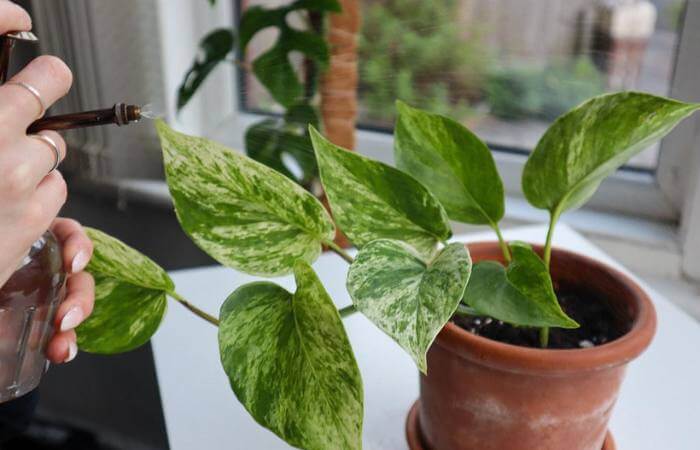
Lack of pruning
Pothos leaves will outgrow their area if you don’t prune them regularly. It causes an excess of leaves, and bugs have more food then. Moreover, too many leaves on a plant will limit ventilation. Water can also accumulate more easily. All these conditions are what bugs love.
Too much misting
Misting is a pleasant treatment for indoor plants. It offers the plants a hydration boost and wipes off the dirt to keep them fresh. Nevertheless, too much misting will be harmful to the Pothos because it creates a wet environment. Then, your plant will welcome houseplant pests.
Conclusion
Indoor plants are susceptible to many indoor plant insects, such as scale insects, fungus gnats, and spider mites. However, you can save your pothos with some treatment. Also, prevent those bugs from accessing your pothos plant by regulating the humidity level properly. Hopefully, bugs won’t be your headache anymore. Contact us to discuss your case if you fail to solve this plant problem. We are always ready to assist you.
FAQs



